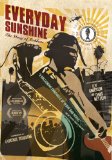| Reviews & Columns |
|
Reviews DVD TV on DVD Blu-ray 4K UHD International DVDs In Theaters Reviews by Studio Video Games Features Collector Series DVDs Easter Egg Database Interviews DVD Talk Radio Feature Articles Columns Anime Talk DVD Savant Horror DVDs The M.O.D. Squad Art House HD Talk Silent DVD
|
DVD Talk Forum |
|
|
| Resources |
|
DVD Price Search Customer Service #'s RCE Info Links |
|
Columns
|
|
|
Everyday Sunshine: The Story of Fishbone
THE MOVIE:
"I wish everyday the sun would shine
Take me to another place in my mind
Where everything is beautiful
And no wants or needs
Nor sign of greed
Could rule our soul."
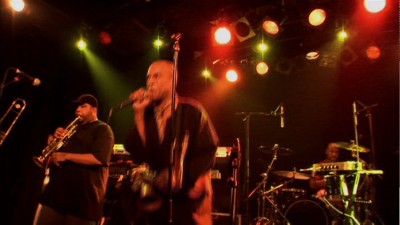
I never thought about this, but I had seen the video for Fishbone's "It's a Wonderful Life (Gonna Have a Time)" before I had ever seen the Frank Capra movie from which the song takes its name and the video stole its footage. It was 1987, and I was 15 and lived and died by MTV's 120 Minutes, their 2-hour block of "alternative" music that started every Sunday night at midnight. I was still developing my musical taste and lived a fair distance from any decent radio station. These pockets of cable television were my only way to really hear things I couldn't find over the FM band. I had started to like punk around then, and Fishbone's raved-up ode to Jimmy Stewart's existential party was fast enough, hard enough, and weird enough to emerge from the pack. At the time, I could maybe afford one record a week. I bought "It's a Wonderful Life" on cassette.
Fast-forward now 25 years, and the music industry is a mess and yet, as fans, we have access to material like never before. As I type, I'm reliving my Fishbone memories via Spotify. I had completely forgotten about their B-side "Love and Bullshit," but there it is, right at my fingertips, a rarity no more. But I digress...
I've come to the computer this evening to write about Everyday Sunshine: The Story of Fishbone, a 2011 documentary by filmmakers Lev Anderson and Chris Metzler. As its subtitle would have you believe, this is the definitive story of the California-born band, a unique rock outfit that combined punk, ska, funk, metal, soul, and really, just about every type of music you could imagine, into one cohesive, exhilarating package. Fishbone was a band that defied categorization, and as the film even points out, confounded all expectations by being a black band on top of everything else. As the idealistic young men in the group discovered, in the early 1980s, African American musicians performed R&B. Hip-hop and rap were still new, though it was about to take over Fishbone's hometown of Los Angeles in a big way. No one from their neighborhoods played rock
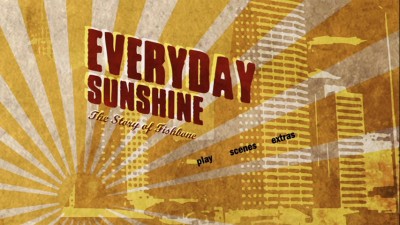
For those who don't know, maybe the closest analogue to Fishbone were the Red Hot Chili Peppers--though it pains me to say it, because I loathe RHCP. Fishbone was a far more eclectic unit. In size, the band was closer to Parliament--they had the usual guitarist/bass/drum combo, as well as a keyboard player and a horn section. They had more than one singer. They had everything, the combinations of varying aesthetics were unheard of, and yet it all seemed as natural as could be. Listening to a Fishbone record, it never seems odd to slip from a Curtis Mayfield cover to an old-school dancehall number to a hardcore punk explosion and then straight into an acoustic ballad, and for all of them to be about social issues, about race and family and oppression. And to all sound like one big party. Fishbone.
Unlike the band, Everyday Sunshine: The Story of Fishbone follows a traditional model. It's a biographical documentary full of talking heads and archival footage. The band members tell their story, augmented by peers and admirers, as well as family members and business people who were there. The interviewees are a who's who of Los Angeles musicians--Flea, Perry Farrell, Gwen Stefani (swoon), Ice-T. Even jazz musician Branford Marsalis admires the band.
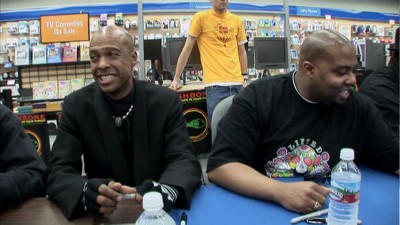
The documentary's narrative starts at the beginning, with the original line-up meeting in junior high in the late 1970s. Most of the guys, including brothers Norwood Fisher (bass) and Fish Fisher (drums) and principle songwriter Chris O'Dowd, were bused to a more suburban school from South Central L.A. There they met Angelo Moore, who had grown up in an all-white neighborhood in the San Fernando Valley (where valley girls came from) and was eager to hang out with other African Americans. He started playing sax and would eventually become Fishbone's ostensible frontman, providing the last piece of the group's incongruous puzzle. The boys all learned their instruments practicing in the Fishers' bedroom, and they started playing out and about at Los Angeles clubs. They were nineteen when they got their record deal with Columbia.
Everyday Sunshine charts Fishbone's artistic rise, their flirting with fame, and the slow dissolution of the original line-up when that fame never came. The usual struggles with ego eventually took their toll, and in one infamous incident, one of the original members, guitarist Kendall Jones, got sucked into a strange religious situation that changed his mental state to such a degree, Norwood Fisher and Jones' brothers tried to stage an intervention, leading to kidnapping charges. Anderson and Metzler jump back and forth between this timeline--which is narrated by actor Laurence Fishburne (whose name spellcheck tries to change to "Fishbone;" coincidence?!)--to more contemporary footage, showing the band as it struggles in a new millennium with only Angelo and Norwood left. It's a pretty depressing portrait of how much things have changed. It only took two decades to shift from "anything goes" to "nothing works."
This juxtaposition is also Everyday Sunshine's Achilles heel. If the documentary has one major flaw, it's that the more "current" footage is not given enough structure to maintain an evident flow of the story. It probably could have been solved with just a few more timestamps. For instance, there is never any indication that the in-store autograph signing we see for the album Stuck in Your Throat is from 2006, and we have no idea when this is in relation to later events, like the European tour or the reunion with Kendall Jones that provides some emotional closure at the tail end of the film. This causes a lot of the storyline to get jumbled. Like Fishbone itself, the film is all over the map.
Anderson and Metzler also make a few other artistic choices that keep Everyday Sunshine: The Story of Fishbone from being as great as it could have been. Where archival footage is not available--specifically, the band's school days and the kidnapping trial--they resort to low-budget animation to fill in the blanks. This tends to distract from the experience rather than engage the viewer (unlike, say, how a similar tactic worked in the recent a Tribe Called Quest documentary). Likewise, they could have been more judicious in the editing process. Some sequences go on too long, and the days following Jones' departure, which are strained and full of struggle, tend to be repetitious. By film's end, one starts to feel Moore and Fisher's fatigue: this stuff really is going on too long.
Despite that, Everyday Sunshine: The Story of Fishbone still manages to capture both the buoyancy of Fishbone's music and the darker aspects of an artistic process that allowed Fishbone to become more than just a party band. There's a lot of interesting stuff here, and the fundamental theme of the documentary is that the same chemistry that can make amazing things happen when it first mixes together can also be the primary agent for tearing a creative unit like Fishbone apart. That two of the guys still forge ahead is remarkable in its own way, and kudos to Lev Anderson and Chris Metzler for paying proper tribute to that perseverance.
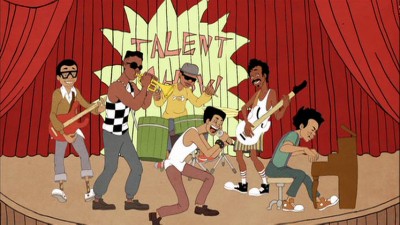
THE DVD
Video:
Cinema Guild presents Everyday Sunshine: The Story of Fishbone in a widescreen format, aspect ratio of 1.85:1. The image quality here is up and down. Some of the blocking and digitized elements strike me as being the result of digital video, a downside to greater technological accessibility; yet, it's so persistent, I started to wonder if there wasn't something that could have been done, because it can be distracting. The material here is cobbled together from a variety of sources, and the pixilation is not limited to, say, old video footage or current tour bus material shot in the dark. The well-lit interviews with, say, Gwen Stefani (swoon!) look just as blocky as a ride in Angelo Moore's car captured on the go. It's not overly terrible, but if your interest in the movie itself starts to wane the way mine did, this technical flaw becomes all the more obvious.
Sound:
The soundtrack is mixed in Dolby 2.0 and sounds pretty good. Even the on-the-fly footage is easy to hear, and the filmmakers never have to resort to subtitling to compensate. The music also sounds excellent, which is important for a documentary about a rock band.
Extras:
There are a ton of extras on the Everyday Sunshine: The Story of Fishbone DVD, which definitely increases the desirability of the overall package. The bonus section is lead by two audio commentaries, one featuring the directors and the second with the band. More specifically, Moore and Fisher sit down to go over the movie and share more anecdotes about the band. The guys disagree about specifics almost from the get-go, but that makes it even more interesting, especially as they dig into the darker days the band went through. History gets twisted in this way, and it's cool to find out how positive they actually are about their present state of being. It's personally interesting for me to hear that some of the footage was shot at Pierce College just two blocks from my house when I was in junior high and still lived in the Valley myself. So close! Amusingly, Moore's mother also calls during the recording and you get to hear them interact in real time.
The extensive interview outtakes section features 23 minutes with all five original Fishbone members and 30 minutes with other musicians, including many that aren't heavily represented (or represented at all), in the feature film, like members of Alice in Chains and Bad Brains, Chuck D, and Michael Franti. There are also three deleted scenes that total just over 11 minutes. It features Angelo and his mother debating over religion, a discussion of musical genres with Branford Marsalis (related to the Fishbone song he played on), and more about Angelo's Dr. Madd Vibe spoken word side project on the occasion of his visit to Yale. I am not sure the professors knew what they were in for.
The featurettes section is next, with short looks at the film's animation, some vintage photography of the band, and a snippet of Moore's Dr. Madd Vibe film. Even this 5-minute clip challenged my patience, I can't imagine watching the whole thing.
Fishbone: Live Through the Years gives us five more selections from different concerts, providing a full thirty minutes of complete performances, beginning with "Skankin' to the Beat" in 1983 and leading to one of the current band members taking a camera with him while he stage dives at a festival (confirming that I never want to crowd surf ever). Other songs include "Got a Fish," "UGLY," and "Modern Industry" in 1985; "Sunless Saturday," "Ma and Pa," and "Everyday Sunshine" at CBGB's in 1991; and the promo video of "Ho Fight" from 2006.
Finally, we get the theatrical trailer.
FINAL THOUGHTS:
Recommended. Everyday Sunshine: The Story of Fishbone is a fascinating, often invigorating rock 'n' roll adventure. From junior high and their bedrooms in South Central Los Angeles, Fishbone exploded on the early 1980s post-punk scene, achieving notoriety over the next decade, and then falling apart in the years following. It's a tale of crazy determination, ego, and an adventurous creative spirit. The documentary could have used some judicious editing to tighten up some of the more arduous sequences, but the bonus features on Everyday Sunshine make up for these failings by enhancing the material in a big way. For fans and non-fans alike.
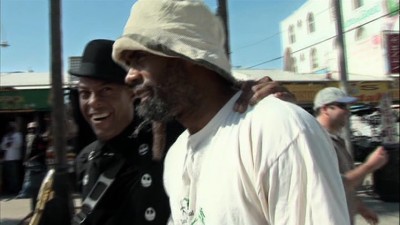
Jamie S. Rich is a novelist and comic book writer. He is best known for his collaborations with Joelle Jones, including the hardboiled crime comic book You Have Killed Me, the challenging romance 12 Reasons Why I Love Her, and the 2007 prose novel Have You Seen the Horizon Lately?, for which Jones did the cover. All three were published by Oni Press. His most recent projects include the futuristic romance A Boy and a Girl with Natalie Nourigat; Archer Coe and the Thousand Natural Shocks, a loopy crime tale drawn by Dan Christensen; and the horror miniseries Madame Frankenstein, a collaboration with Megan Levens. Follow Rich's blog at Confessions123.com.
|
| Popular Reviews |
| Sponsored Links |
|
|
| Sponsored Links |
|
|
| Release List | Reviews | Shop | Newsletter | Forum | DVD Giveaways | Blu-Ray | Advertise |
|
Copyright 2024 DVDTalk.com All Rights Reserved. Legal Info, Privacy Policy, Terms of Use,
Manage Preferences,
Your Privacy Choices | |||||||









